It’s time to look at Brazilian Rainbow Boa care. This is another snake that was thought to be hard to keep but is in fact pretty easy! Keep reading to find out why…
Last updated on February 1st, 2023 at 09:41 am
Named for the astounding iridescence of its scales, the Brazilian Rainbow Boa is a medium-sized constrictor from the Amazon basin. Previously considered a difficult species, herpetoculturists have to come realise that it is in fact quite hardy. All you have to do is give it the correct temperatures and humidity!
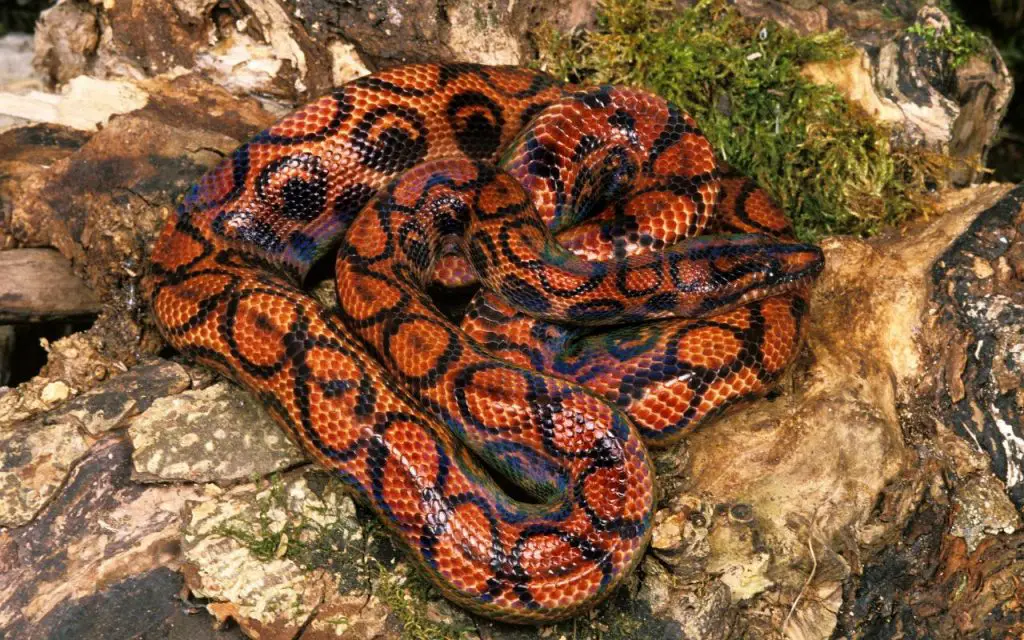
Brazilian Rainbow Boa Size and description
The Brazilian Rainbow Boa (Epicrates c. cenchria) is the nominate subspecies of the Rainbow or Slender Boa (Epicrates cenchria). The genus it belongs to, Epicrates, is comprised of a handful of species that inhabit humid forests all the way from Nicaragua to northern Argentina.
In general, Brazilian Rainbow Boas are slimmer and don’t reach the proportions of stockier boas like the Red Tail Boas (Boa c. constrictor).
Hatchlings are skinny little things, roughly 12 inches long (30cm), and most adults end up around 4.5 – 5ft (1.40 – 1.50). Occasionally, large females can reach 6 or 7ft (1.8 – 2.1m).
Though not as highly developed as in Ball Pythons or Green Tree Pythons, Rainbow Boas do have thermo-receptive labial pits.
Overall, the most striking aspect of this species’ appearance is its bright colouration, overlayed with an iridescent sheen. As with many species, this colour reaches full intensity in adulthood, with some individuals turning a deep red colour.
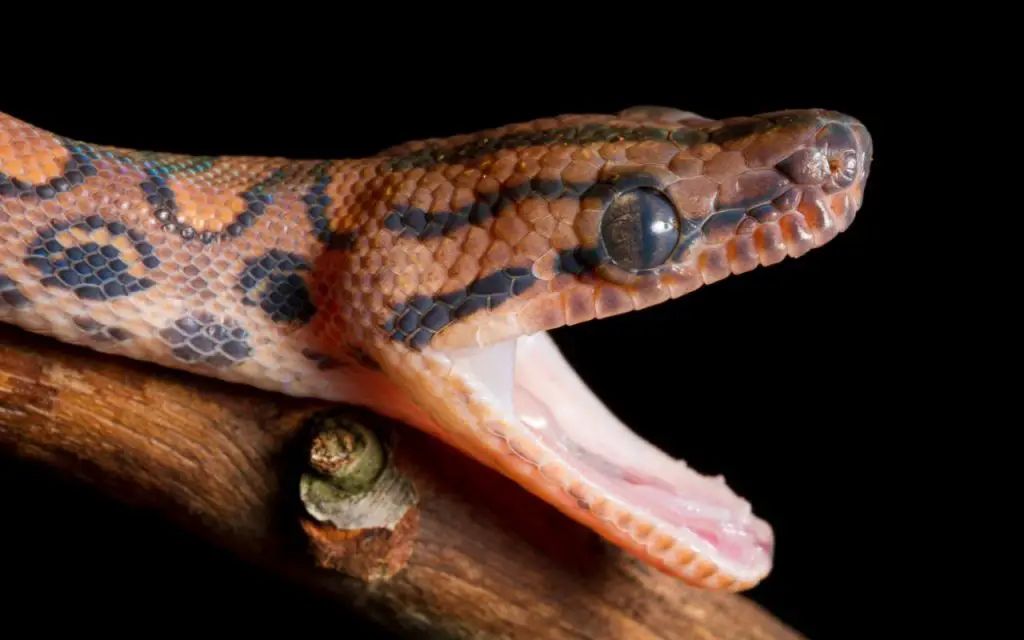
Why are Rainbow Boas iridescent?
The iridescence of this snake is very noticeable and probably only rivalled by that of the Sunbeam Snakes (Xenopeltis spp.).
But why would an animal need to be iridescent? Well, there are several theories about this. My preferred one is that the iridescence is confusing to would-be predators.
Don’t take my word for it though – I’ve found a great study that takes the same point of view. You can find it here: Interference coloration as an anti-predator defence.
Just be aware that scientifically, what we call iridescence is referred to as “interference colouration”.

Rainbow Boa temperament and handling
Like most boas, this is a generally docile, calm species. Nonetheless, they are excessively strong, and this can freak some people out! I say this because they like to wrap around your arm and hang on.
This isn’t aggression though; it’s simply how the snake makes itself feel safe from falling. Bites are uncommon from adults and completely avoidable. As rare as it is, if you do have a grouchy adult, simply put it back if it hisses. Nine times out of ten this avoids any problems.
Some neonates may be quite nippy but they’re just too small to do much damage. With gentle weekly handling they tend to calm down after around a month or two.
Overall, this is not a species that I find scary. The only caveat is that they can have the famous boa appetite! Take care when feeding – it’s the one time you’re likely to get bit. Obviously, using tongs is advised.
Rainbow Boa enclosures
Plastic tubs are probably both the cheapest and easiest to maintain enclosure for this species. Wooden vivariums, on the other hand, are probably the worst. I say this because they will eventually absorb water from the high humidity and deteriorate.
Notwithstanding, tubs aren’t you’re only option. PVC enclosures can be made to exactly the same proportions as wooden vivariums but are lightweight and completely waterproof. For these reasons, PVC is your best option if you want to make a naturalistic enclosure for your pet. Their only drawback is that they can be a little pricey.
When it comes to glass enclosures, these can work reasonably well, but if they have a screen top you must cover most of it with plastic to keep in the humidity.
As far as enclosure size goes, hatchlings are fine in a 12–18inch (30-45cm) tub for their first few months. Adults will need a 3 to 4ft (90 – 120cm) long enclosure, with a height of 12-18 inches (30-45cm) and a depth of 18-24 inches (45 – 60cm). This will depend on their growth, as some do tend to grow larger than others.
Let’s take a look at a nice example of a Brazilian Rainbow Boa setup using a plastic tub. This type of enclosure is easy to make, and both more hygienic and cheaper than bioactive setups.
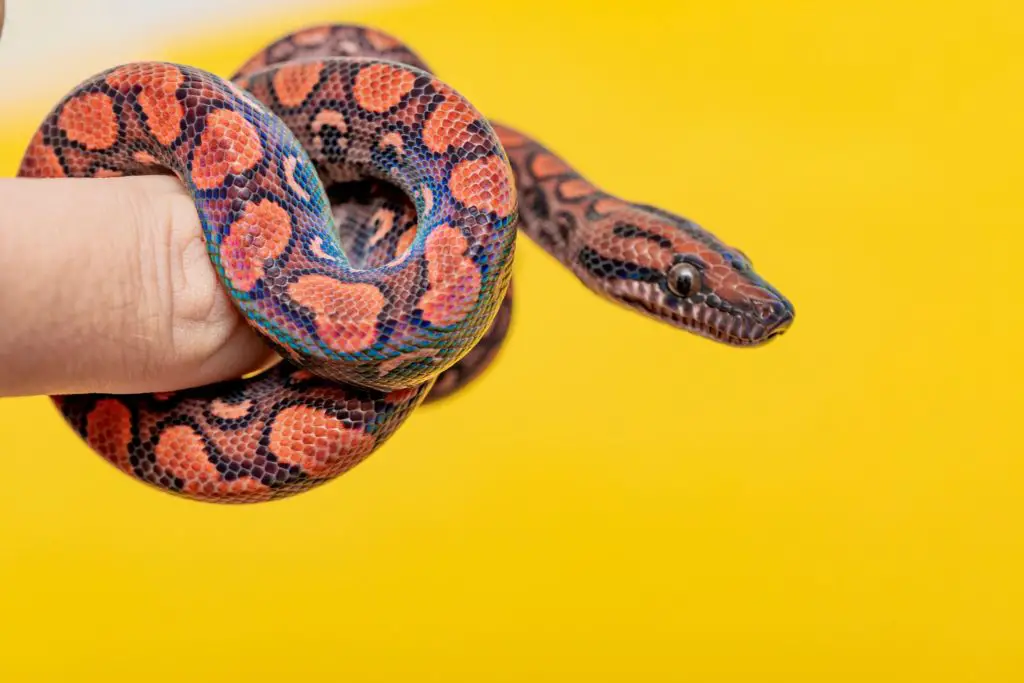
Branches and decorations
Though not quite as shy as some species, these snakes do like clutter. It makes them feel safe and more likely to come out and explore.
Low branches, fake plants and large magnolia leaves are all excellent additions to a Rainbow Boa home. Neonates especially enjoy magnolia leaves.
As adults they don’t climb very high. In fact, they follow a similar ontogenetic shift in body morphology that Boa Constrictors do. That is to say they steadily get more heavy-bodied (and clumsy) as they reach adulthood. Don’t be fooled though, adults still appreciate the low branches.
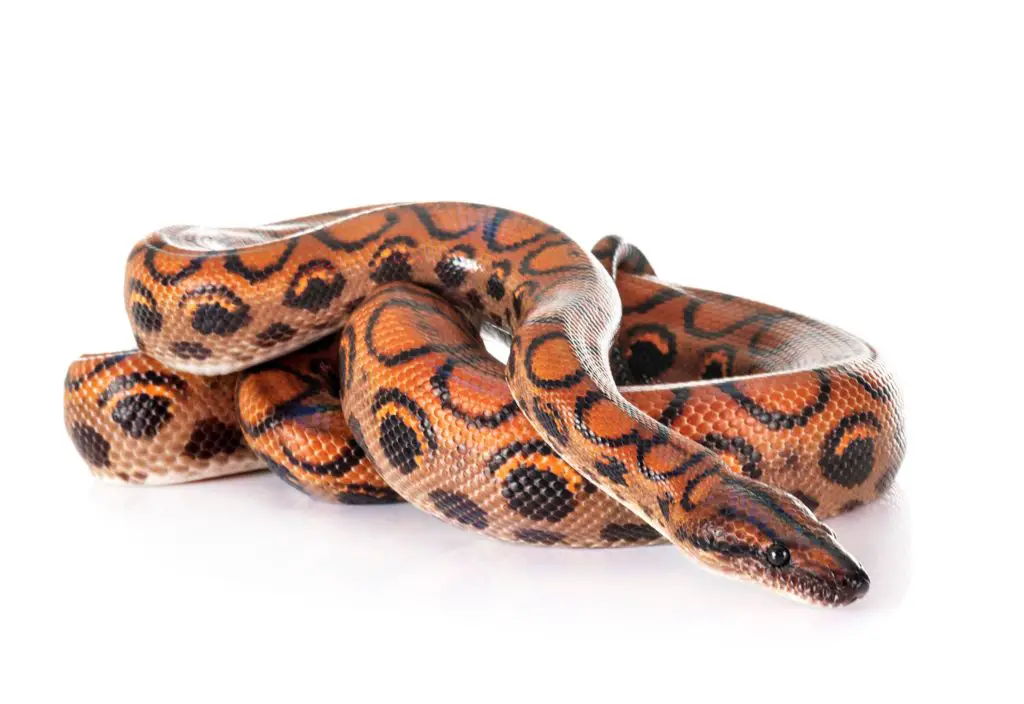
Hides
Rainbow Boas are nocturnal so need safe hiding places they can fit their whole body into. You can use Exo Terra caves or plastic hides for neonates up to a certain size.
For large adults these types of hiding place might be hard to find in the right size. In this case, big sheets of cork bark can work well and look good too.
As always, hides should be available on both the cool and warm end of the enclosure.
Bioactive enclosures for rainbow boas
I usually don’t recommend bioactive because of how germy they are. Generally, I’ll go for a naturalistic but easy to clean enclosure any day. This is probably best for their long-term health, no matter how well-marketed bioactive is.
If you wish to use bioactive, you can make it work but you have to modify how you use it. Spot clean poop immediately and completely strip the enclosure including all substrate for cleaning every few months.
While this sounds like a lot of work, it will help reduce the build-up of germs like Salmonella and parasites such as Flagellates.

Substrate
Coconut husk is a very good substrate for Rainbow Boas. It used to be hard to find but is becoming widely available now. It retains moisture extremely well and come ins chips which makes it less dusty.
Orchid bark and cypress mulch also work great but are generally more expensive. There are also doubts over how sustainable cypress mulch is.
Whichever substrate you choose, add sphagnum moss here and there for increased water retention and humidity.
If going the bioactive route you can use potting soil, but in this case make sure your heat is from above or that the depth of the soil is no more than a couple inches (5 cm).
Brazilian Rainbow Boa Temperature
Not too hot! These snakes are from the tropical rainforests of the amazon basin. Rainforests never get too hot, or too cold. That’s why they are so stable and encourage such massive biodiversity.
Ideal temperatures for the Brazilian Rainbow Boa are a gradient from 72f (22c) on the cool end to 82f (28c) on the warm end. At night, these temperatures can drop slightly, but not more than a couple of degrees.
Heat pads are still the best for heating extremely high humidity snake species, but only because they’re cheap and widely available.
Radiant heat panels are more expensive and less commonly used, but an excellent choice, nonetheless. For reference, you can see them in use in my Green Tree Python Care Sheet.
My personal preference would be for a heat pad if using a tub setup, or a radiant heat panel mounted on the roof for a larger, naturalistic enclosure.
There’s been a lot of debate about what kind of heat is best for reptiles recently. Some people say that heat pads don’t produce the right kind of infrared etc. and that deep heat projectors are “the only thing that heats like the sun”.
Well, Rainbow boas live deep in the jungle, they don’t get a lot of sun! In fact, the temperature they are used to is regulated by the forest ecosystem. It is purely ambient, unlike the solar heat desert species are used to.
This has simply been another case of clever marketing. If something feels warm, it’s warm. Period. Heat mats get warm, as does every other available heating appliance. What really counts is getting the temperature correct!
Brazilian Rainbow Boa Humidity and water
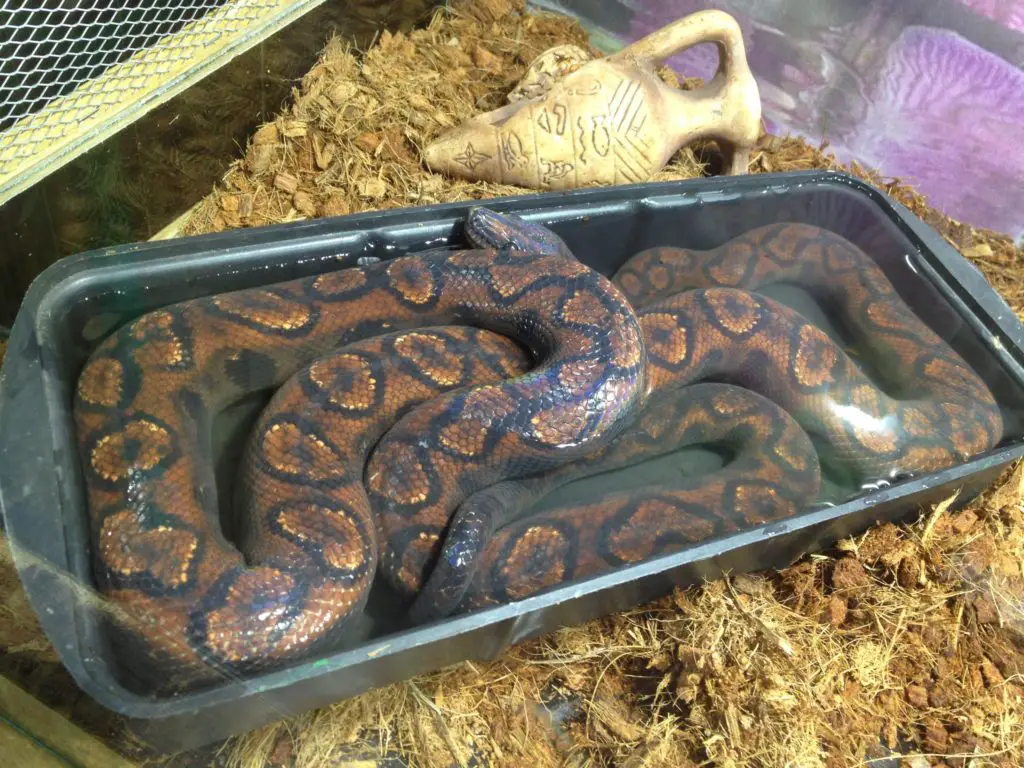
Humidity needs to be high – especially for neonates and subadults. No drying out – ever. For species like this, low humidity is highly likely to cause illness, particularly where the respiratory system is concerned.
For adults, humidity should be maintained at 80%, give or take 5%. Where neonates and subadults are concerned, the humidity should be as high as possible without the substrate actually being wet. This usually translates to about 90-95%.
Failure to maintain high humidity will result in poor shedding and constipation quite quickly, so this point is very important.
In addition to these humidity levels, provide them with a water bowl large enough to soak their whole body. This applies to all ages.
If you find that you are struggled to maintain humidity, try misting daily and placing the water bowl near the heat source.
Should I get a humid box for my Rainbow Boa?
This is a common question, and my answer is yes, definitely. It’s very easy to make one. All you need to do is fill a plastic or resin hide with damp sphagnum moss. If your snake does take advantage of the feature during shedding it will greatly help the process.
In all honesty, many snakes will never bother using a humid box. But when it’s such a simple thing to do, you won’t have wasted too much time and effort.
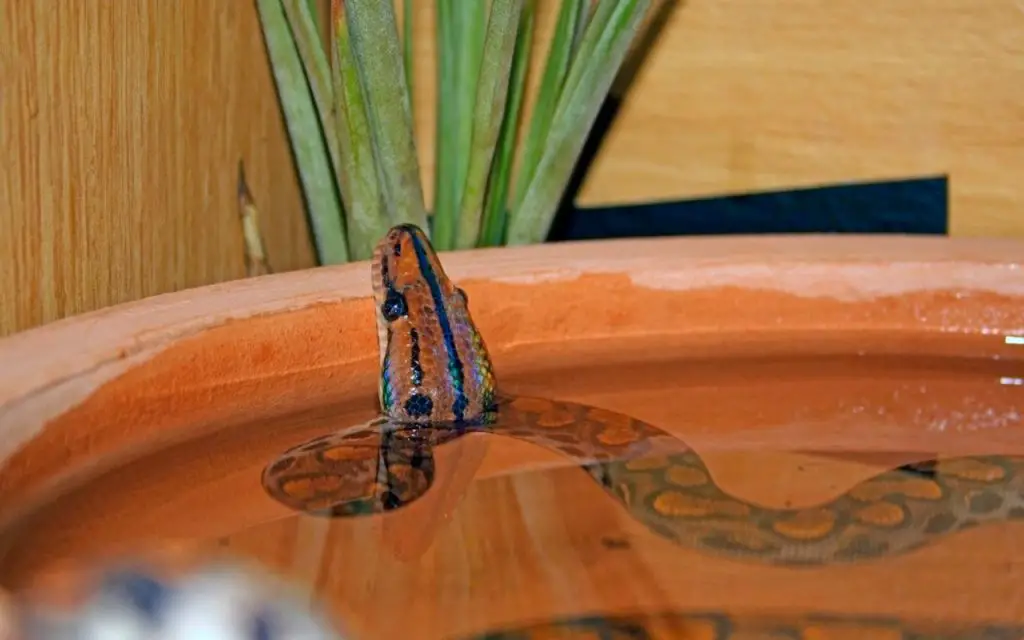
Hygiene
I can here you say it now: 80% HUMIDITY! WHAT ABOUT SCALE ROT? Well, don’t worry. Rainbow Boas are physiologically adapted to a highly humid environment. This means that the only way they can catch Scale Rot is from living in filthy conditions.
Maintain good enclosure hygiene and your Rainbow Boa will be safe from the disease. That is all there is to it!
Clean out any mess it makes immediately, and completely clean out and disinfect the enclosure every 2-3 months if it’s bioactive, or once a month if not.
Lighting
As I mention earlier, there isn’t much sun in the dense rainforest undergrowth. In fact, last time I was there, I couldn’t get a solar power bank to charge. Rainbow Boas have adapted to these conditions and being nocturnal really have no specific need for UV lighting.
However, many keepers enjoy observing their snakes. And a naturalistic enclosure with lighting looks great as a centre piece of a room. It’s also worth mentioning that these Boas aren’t as shy as Ball Pythons, so adding lighting is unlikely to make them feed less.
If you have made a naturalistic enclosure, I would recommend using an LED light strip to light it. These emit almost no heat and will not remove too much humidity.
For Bioactive enclosures, UV lighting is definitely worthwhile, as it will help the plants to thrive.
Like I say, Rainbow Boas don’t need artificial light, but they do need to know whether it’s night or day. If you don’t install lights, just make sure there is light coming into the room from a window, or a light left on in the room for most of the day.
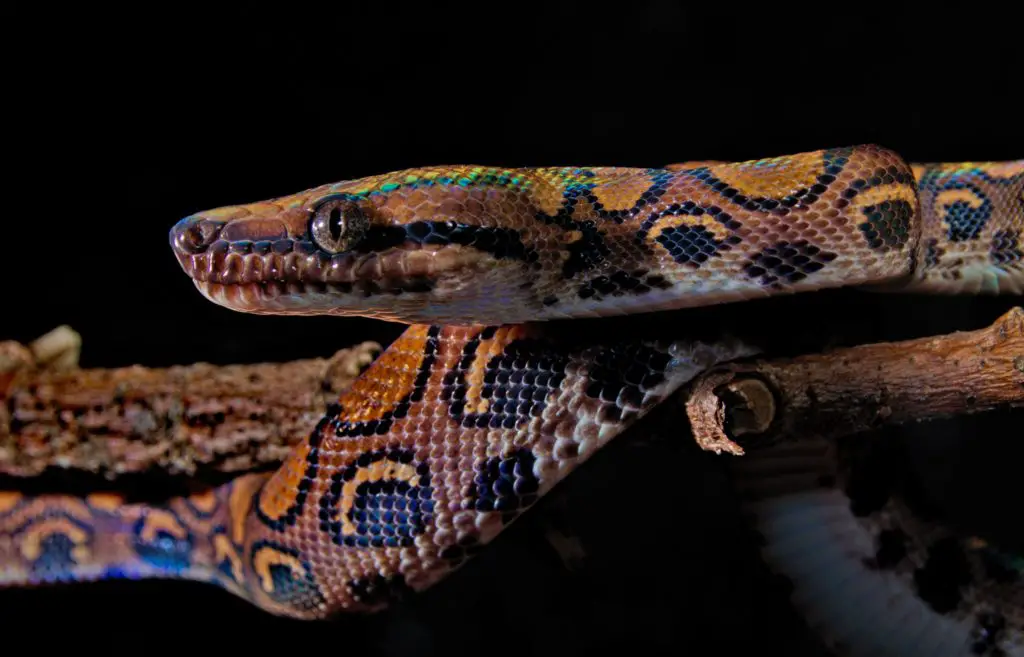
What do Rainbow Boas eat?
Most are happy with a diet of rats as adults and mice or rats when young. Feed neonates every 5 days a meal that is a little wider than their body.
After a couple of months go down to one feed every 7 days, upgrading the size of the prey in line with the snake’s growth. Your baby might go from eating rat fluffs to rat chubs, for example.
As adults, they like rats, chicks, quails, and even very small rabbits. I recommend sticking to rats, if possible, with the occasional chick (or very small chicken) for variety.
Only feed adults every 10-14 days. They have a slow metabolism and look very weird if you let them get obese!
As always, frozen-thawed prey is the safest food your pet. Just remember that these snakes have thermo-receptive labial pits, meaning they may refuse food if it isn’t warmed up nicely. I do this by letting it thaw out during the day, then putting it inside a sealable plastic sandwich bag and submerging it in warm water for 10 minutes.

Are Rainbow Boas good pets?
Rainbow Boas are definitely good pets. They take well to a rodent-based diet, have simple care requirements (asides from the humidity issue), and can become very docile.
In fact, under the correct conditions, they have a captive lifespan of 20 years or more.
As time goes by, this species is set to become more widely available, probably eventually becoming a common alternative to Boa Constrictors.
Brazilian Rainbow Boas for sale
Slowly but surely, this species is becoming more widely available. In North America and Europe, you can now find captive bred neonates for sale on a regular basis. Nonetheless, prices remain stubbornly high, often around the $300 mark.
If you see an adult for sale, make sure it is captive bred. Wild caught Rainbow Boas can have a heavy parasite load (amongst other issues) but are very easy to recognize due to how skinny they are.
As always, seeking out an experience breeder with a good reputation is the best way to go.
Rainbow Boa Care Summary
| Temperature: | 72f (22c) on the cool end to 82f (28c) on the warm end |
| Humidity: | 90%+ for neonates, 80% for adults |
| Favourite food: | Rats and mice |
| Enclosure size: | 12–18inch (30-45cm) long for neonates, 3 to 4ft (90 – 120cm) long, with a height of 12-18 inches (30-45cm) and a depth of 18-24 inches (45 – 60cm) for adults |
| Activity rythm: | Nocturnal |
| Lighting needs: | UV not necessary, but ambient beneficial |
| Availability: | Average |
Wrapping up
Rainbow Boas are a beautiful species that reaches an ideal size for both handling and housing. Their only drawbacks are that their humidity needs to be high, and you must not overheat them! If you get either of these points wrong, they will quickly decline in health.
If, on the other hand, you get these two factors right – you’ll have a pet that will be just as hardy as most other pet snakes. It really is just a question of consistency.
In the past, a lot of people bought the idea they were hard to keep, but I think it’s time to change this point of view!
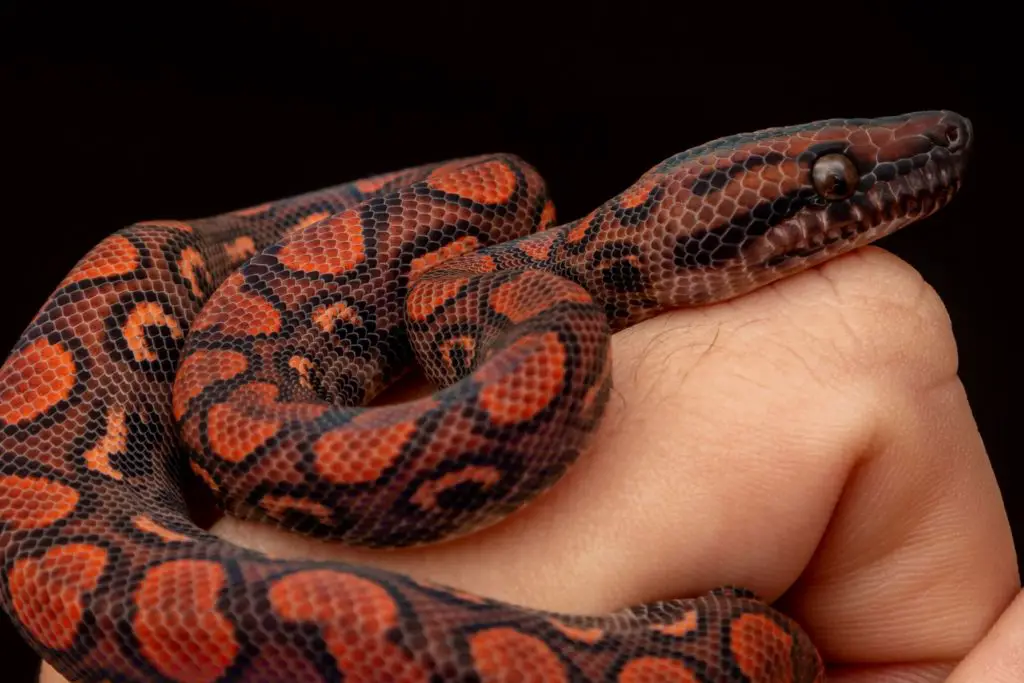
Key points to remember about Rainbow Boa care
- Hailing from tropical zones of South America, Rainbow Boas (including Colombian Rainbow Boas) will quickly run into health issues if they are not provided with constant, high humidity levels. Even with great humidity, it is always a good idea to provide them with a humid hide and a large water bowl to soak in.
- Do not be afraid of this high humidy causing respiratory infections or bacterial infections – these snakes are used to dampness in their natural habitat, which is why they have such high humidy requirements in the first place. They will only get sick if you fail to keep them clean.
- Like all snakes, Rainbow Boas should be given a temperature gradient in their enclosure, meaning a warm side and a cool side. Be aware, though, that ceramic heat emitters are a poor choice of heating element because they dry out the substrate so much. Same goes for a heat lamp. Instead, opt for a radiant heat panel, high-capacity heat mat or regular heat mat.
- Rainbow Boas do fine without UVB lighting. The only reason many sights advise you to get a UVB bulb is to hopefully make more money out of you.
- Humidity is always harder to maintain in larger enclosures: for baby Rainbow Boas I recommend starting them off in small tubs, then upgrading as they grow.
- Baby Brazilian Rainbow Boas should be fed appropriately sized food items every 5 to 7 days, but adult Rainbow Boas must eat less often. They are highly susceptible to obesity. This website does not recommend feeding live rodents – especially as Boas are easy to tempt with frozen-thawed prey.
- Do not make their ambient temperature too high. These snakes spend a lot of time on the forest floor (or just above it) in their natural environment, where temperatures are nowhere near as hot as they are outside of the rainforest.
